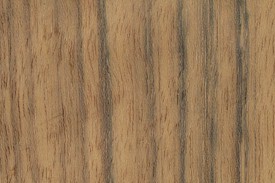Ovengkol Wood
Explore the distinctive features, uses, and characteristics of Ovengkol wood, known for its warm brown color with darker brown or black streaks.
Wood Description
Ovengkol wood is recognized for its warm brown color, often with darker brown or black streaks. The texture is medium to coarse, and the grain is typically straight, though it can be interlocked. The wood has a natural luster and can exhibit an attractive figure.

Background
Ovengkol wood, also known as shedua or amazakoue, is a distinctive and durable hardwood native to West Africa, particularly found in countries like Ghana, Ivory Coast, and Nigeria. Derived from the tree species Guibourtia ehie, ovengkol belongs to the same family as bubinga and is often used as an alternative to more expensive woods like rosewood.
Renowned for its unique aesthetic and robust properties, ovengkol wood features a color palette that ranges from a light yellow-brown to a darker chocolate brown, often with gray or black streaks. Its texture is medium to coarse, with an interlocked grain that can create striking patterns, especially when quarter-sawn.
A key attribute of ovengkol wood is its excellent strength and durability. It possesses a good balance of hardness and density, making it resistant to scratches and general wear. This strength, coupled with its natural resistance to decay and pests, renders ovengkol suitable for both indoor and outdoor applications.
In terms of workability, ovengkol is generally user-friendly. It machines well, though the interlocked grain may require attention to avoid tearout. The wood glues, stains, and finishes effectively, allowing for a wide range of aesthetic possibilities in the final product.
Ovengkol's versatility is evident in its wide range of uses. It is commonly employed in the making of fine furniture, cabinetry, and flooring. Its excellent acoustic properties also make it a favored choice for musical instruments, particularly guitar bodies and fingerboards. Additionally, ovengkol is used in decorative veneers, turned objects, and specialty items like knife handles.
To sum up, ovengkol wood is a versatile, strong, and visually appealing hardwood. Its unique color variations, durability, and workability make it a popular choice for various applications, from exquisite furniture and musical instruments to durable flooring and ornamental objects.
Physical Properties
- Specific Gravity: 0.65 (Mean)
- Crushing Strength: 54 MPa (Mean)
- Modulus of Rupture: 98 MPa (Mean)
- Modulus of Elasticity: 12.3 GPa (Mean)
Durability and Treatability
Ovengkol wood is moderately durable, offering fair resistance to fungi and insect attack. It is not particularly susceptible to termites and is moderately resistant to preservative treatment. Ovengkol is suitable for both interior and exterior applications.